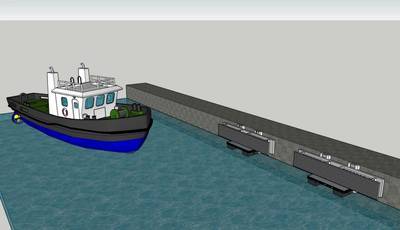
A new innovative device has been engineered to improve docking safety.
Designed to be installed on quay walls, the Dynamic Protective Barrier features a novel mechanism to dissipate energy for short duration impact caused by docking vessels.
Matthew Czerniatewicz, founder of Dynamic Protective Barriers (DPB), said other solutions available on the market today typically absorb and accumulate the kinetic energy at the point of docking, which can cause micro and macro damages to the port infrastructure and as well as the ship. “The constant volume of docking and mooring promotes deterioration and destruction. Therefore, there’s a need for a new solution that contains the ship to promote safety and reduce the damages to the quay walls and the ship as well,” he explained.
“We developed a patented device called Dynamic Protective Barrier, which is a one-of-a-kind safety solution that disperses the kinetic energy at the point of impact in a safe manner,” Czerniatewicz said. “[Our solution] not only protects the infrastructure of the ports, the ships, but most importantly, it improves the safety by containment of the ship while docking.”
Gagandeep Singh, team engineer at DPB, said the device effectively converts translational kinetic energy to rotational kinetic energy on the impact of the vessel. “When the boats are docking, the impact is usually translational kinetic energy. . . Our device channels this energy into rotational kinetic energy, thereby dispersing all the energy generated by the impact of the docking vessel.”
The system is engineered to be installed in existing infrastructure with a tracking system that adjusts vertically based around tidal changes. It is also equipped with a self-returning system and is designed to engage and retract with the vessel constantly so that it stays in touch and actively dissipates any energy that is generated.
Czerniatewicz said DPB has been testing a prototype with a 25-ton vessel at a port facility in Europe, but noted the company is seeking partners to take the technology to the next level. “We are consistently testing the performance of the device to its optimum level. The same device has been used for testing since its inception and we have yet to seen any failures or damages.”
Czerniatewicz added, “We would like to collaborate, further test the industry standard requirements in a live setting. Our goal is to launch our device to the market where ports and marinas can experience the benefits from this new technology because we strongly believe we can make a difference in enhancing safety and bring substantial cost savings to the industry.”
Having already scoped out several ports in Europe, North America and South America, DPB initially targeting ports and marinas where smaller vessels dock, but noted the technology is scalable to serve larger ships and yachts too.
“Our device does not absorb or store any energy. This is possible by the use of interchangeable masses, where the impact is dissipated in an instant timeframe,” Singh said. “This can be catered to vessels of different masses and sizes because if we increase the interchangeable masses, we can go higher up the ladder and go for vessels with higher masses and sizes. So basically, we can disperse energy from bigger vessels as well.”


